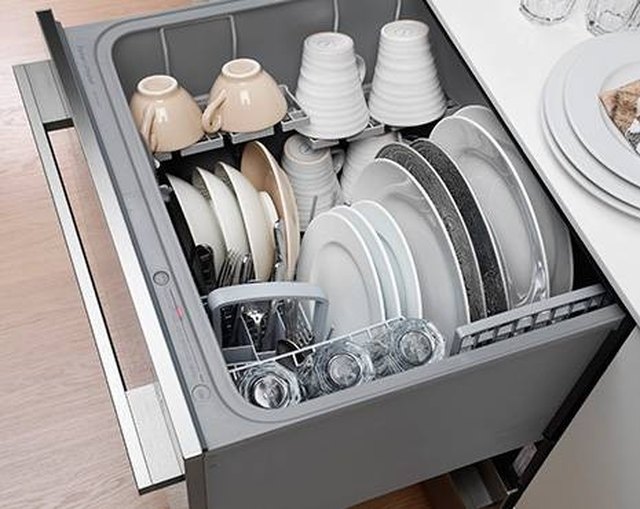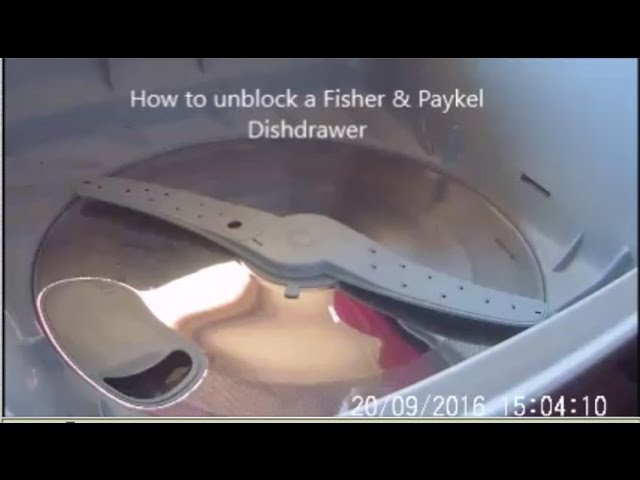If your Fisher Paykel Dishdrawer is not draining, check for any kinks in the drainage hose and straighten them out. If the kinks persist, you may need to replace the hose.
Additionally, clean the filter plate and drain filter to ensure they are not clogged. It is recommended to clean your Dishdrawer at least once a month.
Common Reasons For Fisher Paykel Dishdrawer Not Draining
Clogged Drainage System
One of the most common reasons for a Fisher Paykel DishDrawer not draining is a clogged drainage system. Over time, food particles or debris can accumulate and block the drainage system, preventing water from properly draining out of the dishwasher. To address this issue, follow these steps:
- Check the dishwasher drain and clean the drain basket around the lower sprayer arm.
- Unclog any debris using a wire hanger or other suitable tool.
Kinks in the Drainage Hose
Another common reason for a Fisher Paykel DishDrawer not draining is kinks in the drainage hose. If the hose is bent or kinked, it can obstruct the flow of water and prevent proper drainage. To fix this issue, try the following:
- Straighten out any kinks in the hose that drains water from the DishDrawer™.
- If the kinks return, it may be necessary to consider replacing the hose to ensure proper drainage.
Dirty Filter Plate/Drain Filter
A dirty filter plate or drain filter can also cause drainage problems in a Fisher Paykel DishDrawer. It is important to clean the DishDrawer™ regularly, including the filter plates, to ensure proper drainage. Here is a step-by-step guide on cleaning the filter plate and drain filter:
- Remove the filter plate from the DishDrawer™.
- Rinse the filter plate under running water to remove any food particles or debris.
- Clean any remaining residue with a mild dish soap and a soft brush or sponge.
- Rinse the filter plate thoroughly and allow it to dry completely before reinserting it into the DishDrawer™.
By addressing these common issues, such as a clogged drainage system, kinks in the drainage hose, or a dirty filter plate/drain filter, you can ensure that your Fisher Paykel DishDrawer drains properly and efficiently. Remember to perform regular maintenance and cleaning to prevent these problems from occurring in the future.

Credit: www.hunker.com
How To Troubleshoot And Fix A Fisher Paykel Dishdrawer Not Draining
If you’re experiencing issues with your Fisher Paykel Dishdrawer not draining properly, don’t worry! This guide will walk you through the troubleshooting steps to help you identify and fix the problem. Follow each step carefully to ensure your Dishdrawer is functioning as it should.
Step 1: Disassembling Interior Components
Before getting to the root cause of the drainage issue, it’s important to disassemble the interior components of your Dishdrawer for easier access. Follow these instructions:
- Turn off the power to the Dishdrawer to ensure your safety.
- Remove the dishes and racks from the Drawer, setting them aside.
- Locate the clips or screws that secure the front panel and remove them using a screwdriver or appropriate tool.
- Gently pull the front panel towards you to release it from the Drawer housing.
- Next, remove the top panel by loosening the screws on each side and lifting it off.
- You should now have clear access to the interior components of the Dishdrawer.
Step 2: Removing Pump and Obstructions
Once you have disassembled the Dishdrawer and have access to the inner components, it’s time to address any obstructions that may be causing the drainage issue. Follow these steps:
- Locate the drain pump, usually positioned at the back of the Drawer.
- Disconnect the power and water supply lines connected to the pump.
- Using pliers or a wrench, carefully remove the pump from its housing.
- Inspect the pump and drain hose for any clogs, debris, or foreign objects.
- If you find any blockages, remove them using a wire hanger or similar tool.
- Ensure that the pump and drain hose are clean and free from any obstructions.
- Once cleared, reassemble the pump back into its housing.
Step 3: Reassembling the Dishdrawer
After addressing the drainage issue and ensuring that there are no more blockages or obstructions, it’s time to reassemble the Dishdrawer. Follow these instructions:
- Start by placing the top panel back onto the Drawer and securing it with the screws on each side.
- With the top panel in place, slide the front panel onto the Drawer housing until it locks securely.
- Finally, reattach the clips or screws that secure the front panel, ensuring it is firmly in place.
- Turn on the power and test the Drain function to ensure that the Dishdrawer is now draining properly.
By following these steps, you should be able to troubleshoot and fix the drainage issues with your Fisher Paykel Dishdrawer. Remember to always practice safety precautions and consult the manufacturer’s manual for specific instructions. If the problem persists, it is recommended to contact a professional technician for further assistance.
Additional Tips For Maintaining A Properly Draining Fisher Paykel Dishdrawer
Regular maintenance is essential for ensuring that your Fisher Paykel Dishdrawer drains properly and avoids future drainage issues. By following a few simple steps and keeping an eye out for common problems, you can keep your Dishdrawer in top condition. In this section, we’ll discuss the importance of a regular cleaning schedule, how to check for common issues, troubleshooting tips, and when to seek professional help or contact Fisher Paykel for warranty coverage.
Regular DishDrawer™ Cleaning Schedule
Creating a regular cleaning schedule for your Fisher Paykel Dishdrawer is essential to prevent drainage issues. Aim to clean your Dishdrawer at least once per month, including the drain filter plates. Regular cleaning helps remove any accumulated debris, food particles, or soap scum that can clog the drainage system. It also helps maintain optimal performance and extends the lifespan of your Dishdrawer.
Importance of regular cleaning to prevent future drainage issues
Regular cleaning is crucial to prevent future drainage issues with your Fisher Paykel Dishdrawer. If debris or food particles are not properly removed, they can accumulate and clog the drainage system over time, leading to water backup and poor drainage. By maintaining a consistent cleaning schedule, you can minimize the risk of clogs and ensure that your Dishdrawer operates smoothly.
Recommendations on how often to clean the DishDrawer™
We recommend cleaning your Fisher Paykel Dishdrawer at least once per month. However, depending on your usage and the amount of debris in your dishes, you may need to clean it more frequently. Pay attention to any signs of poor drainage, such as standing water or lingering odors, as these may indicate that your Dishdrawer needs cleaning.
Checking for Common Issues
Regularly checking your Fisher Paykel Dishdrawer for common issues can help you identify potential problems before they escalate. Look out for worn-out components or faulty connections that can affect the drainage system. Inspect the hoses for any kinks or blockages, and straighten them if necessary. Additionally, clean the drain basket and spray arms to ensure proper water flow and drainage.
Identifying potential issues such as worn-out components or faulty connections
Inspecting your Fisher Paykel Dishdrawer for worn-out components or faulty connections is crucial in maintaining proper drainage. Check the hoses, pump, and drain filter plates for any signs of damage or wear. Look out for leaks or loose connections that can affect the Dishdrawer’s performance. By identifying these issues early on, you can take prompt action to prevent further damage and ensure a properly draining Dishdrawer.
Tips on troubleshooting problems beyond simple drainage issues
If you encounter problems beyond simple drainage issues with your Fisher Paykel Dishdrawer, here are a few troubleshooting tips to consider:
- Check the power supply: Ensure that the Dishdrawer is properly connected to a power source and that there are no electrical issues.
- Inspect the control panel: Look for any error codes or malfunctions indicated on the control panel and follow the manufacturer’s instructions for troubleshooting.
- Clean the spray arms: Remove and clean the spray arms to ensure proper water flow and pressure.
- Reset the Dishdrawer: Sometimes, resetting the Dishdrawer can resolve minor issues. Refer to the user manual for instructions on how to perform a reset.
Professional Help and Warranty Coverage
If you’re unable to resolve the drainage issue or encounter more significant problems with your Fisher Paykel Dishdrawer, it might be time to seek professional assistance. Contact a qualified technician who specializes in Fisher Paykel appliances for expert diagnosis and repairs. Additionally, if your Dishdrawer is still under warranty, consider contacting Fisher Paykel directly for warranty coverage. Remember to follow safety guidelines and avoid attempting any DIY repairs that could result in further damage or voiding the warranty.
Frequently Asked Questions On Fisher Paykel Dishdrawer Not Draining
Why Is My Fisher And Paykel Dishdrawer Not Draining?
If your Fisher and Paykel DishDrawer is not draining, check for any kinks in the drain hose and straighten them out. If the problem persists, you may need to replace the hose. Additionally, clean the filter plate and drain filter to ensure proper drainage.
How Do You Drain A Fisher Paykel Dishwasher Drawer?
To drain a Fisher Paykel dishwasher drawer, straighten any kinks in the drainage hose and replace it if necessary. Clean the filter plate and drain filter monthly to prevent clogging. If water remains at the bottom, check the drainage system for debris and unclog it with a wire hanger.
Why Is There Water At The Bottom Of My Dishwasher Drawer?
There may be water at the bottom of your dishwasher drawer because the drainage system is clogged with food particles or debris. Check the drain and clean the drain basket to unclog any obstructions. Straighten any kinks in the drain hose and consider replacing it if the issue persists.
How Do You Drain The Water From A Fisher And Paykel Washing Machine?
To drain the water from a Fisher and Paykel washing machine, straighten any kinks in the drain hose. If the kinks return, replace the hose. Clean the filter plate or drain filter at least once a month to prevent clogging.
Why Is My Fisher Paykel Dishdrawer Not Draining?
Straighten any kinks along the hose that drains water from your DishDrawer™. If the kinks return, you may need to replace the hose. Clean the filter plate/drain filter. Aim to clean your DishDrawer™ at least once per month, including the drain filter plates.
Conclusion
If your Fisher Paykel Dishdrawer is not draining, there are a few possible solutions. First, check for any kinks in the drainage hose and straighten them out. If the kinks keep returning, you may need to replace the hose. It’s also important to regularly clean the filter plate and drain filter to prevent clogging.
Remember to clean your Dishdrawer at least once a month. By following these steps, you can help ensure that your Dishdrawer drains properly and avoid any further issues.

